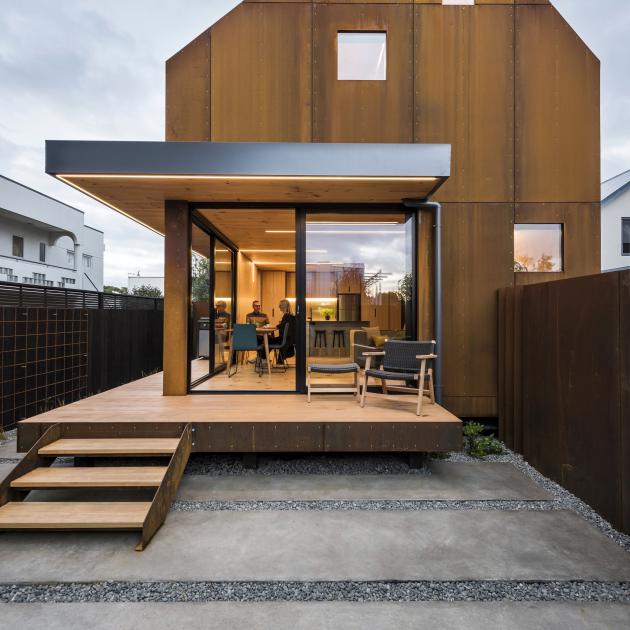

He grew up roaming the South Canterbury back-country and spent many a happy holiday overnighting in the simple hunting cabins that dot the landscape. While doing so, he grew to appreciate not only their sheltering presence in an often intimidating landscape, but also how they met that need: "They’re so utilitarian — hard-wearing and functional. They’re designed to wear in over time, not wear out. I’m firmly of the belief that a national building code that requires buildings to have only a fifty-year lifespan needs upgrading."
These values informed both the design and every millimetre of the construction of the small, intriguing building on the edge of Christchurch’s CBD that earned Coll the Supreme Award in the 2017 ADNZ/Resene Architectural Design Awards and a shared award for a residential multi-unit development, among others.
Described by the judges as "an exemplar of urban living", its duplex mirror-image homes (connected back-to-back along a shared common wall) are snugly packed on to a narrow 300sq m site and, at only 74sq m each over two storeys, can definitely be described as compact.

"Building two houses arose from the fact that we only needed a small home on a site half this size, but as this was the site we had, you could say I designed to the site."

"I’ve always been interested in designing with cost efficiency in mind. It means I have to consider every element, whether they be the materials used, the type of construction, the structural elements — every square metre has to justify its existence.
"By building a house small and design-dense, the money saved can be spent on quality. The maths aren’t complicated — if you halve the size, you get twice the quality and the overall price, which is what really matters, is still low."
The impression of quality is immediate, even though the form — steeply gabled, and very nearly twice as high as it is wide — is as straightforward as that of the cabins that inspired it. It is the juxtaposition between this simplicity and the challenge posed by the cladding materials of Cor-Ten steel and wide-tray roofing iron that gives pause for thought.


The rear unit is rented out and contributes to the mortgage, and although at present the front house fulfils every one of Coll and his partner Amy’s needs, future proofing was a consideration. Doors cut through the party wall would allow the two dwellings to become one large family home (this would require a building permit as it’s a fire-rated wall, and an encumbrance added to the title). Should use of the site change in the future, the two homes could be uncoupled and moved intact without the need for radical deconstruction.
In the case of the unthinkable happening — earth movement from another earthquake — the foundation system means that the houses could be relevelled quickly and efficiently.
Although it is a resolutely urban addition to the Christchurch rebuild, Coll has got his trusty cabin. "We’ve got the best of all worlds. It’s strong, handsome, easy to live in — and right in the heart of the city."
AT A GLANCE
Duplex houses on one site, one providing a home, the other a long- term income stream.
Each house is 74sq m.
Location: Madras St, Christchurch central.
Architect: Mitchell Coll, Coll Architecture.
Site size: 306sq m.
Builder: Feutz and Goldsmith Builders Ltd.
Costs:
- Land: $215,000.
- Build: $361,000 per house. ($4878 per square metre); $722,000 in total.
- Landscaping: $57,000.
- Fees and compliance (including. surveying and engineering fees, subdivision costs and building permit; no development contribution required; excluding architectural fees): $47,000.
- Total: $1,041,000 (all costs divided between two houses).











